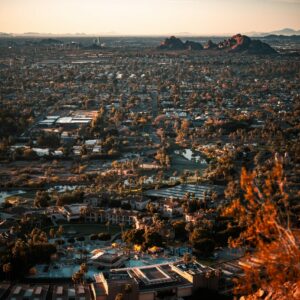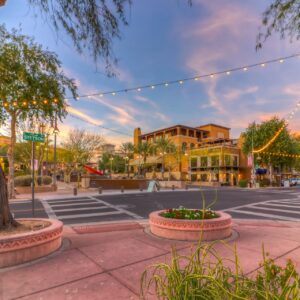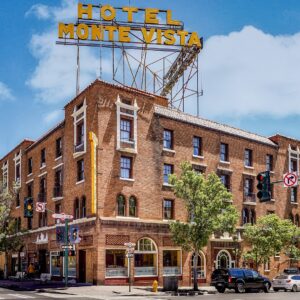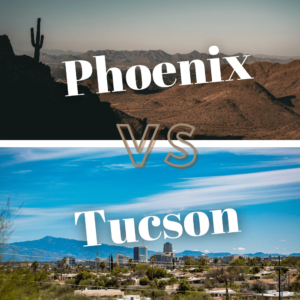Why is Phoenix So Big? 5 Major Reasons (Explained)
Why is Phoenix so big? It’s not near any major water sources and its heat is unbearable at times. So, we found 5 reasons that have fueled Phoenix’s growth.
It’s a city with wide-open spaces and extra-wide highways that has also become the fastest growing city in the whole US. What has driven this popularity and will it continue to expand at the same rate in the future?
Also, are we talking about “big” in the sense of its population or the actual space it takes up? Or both?
We took a deep dive into the historical facts and read through many stories to figure out why Phoenix is so big currently. The results are a mix of good planning and some luck.
Let’s take a look at the reasons why Phoenix is so big.
Table of Contents
Why is Phoenix So Big? Historic Events

Phoenix was a quiet little city for much of its early days. In fact, Phoenix’s population was only 65,000 until the 1940s (compared to its 1.5 million residents in 2023).
A major shift occurred right after World War II. During the war, many US soldiers were stationed at military bases in and around Phoenix.
After the war, many of them went back and settled in the city since it offered them cheap housing and sunshine all year round.
Meanwhile, in the 1950s, the technology of air conditioning started to become more mainstream and accessible for normal, middle class families to afford.
That invention helped transform Phoenix from an almost unlivable desert to a comfortable, climate controlled community.
By the 1960s, Phoenix’s population ballooned to over 400,000 people. But, that still doesn’t fully answer the question of “why is Phoenix so big”, so we need to look at the next point to understand more.
Why is Phoenix So Big? Available Space
Phoenix has a very large population, but not all large cities are physically big in regards to the amount of land that they take up.
Places like New York City and San Francisco are very dense and pack in a lot of residents into a small area, which is due to its geographic features.
Just for comparison, Manhattan and Phoenix have roughly the same population. However, the density in Manhattan is about 75,000 people per square mile, while in Phoenix, it is only about 3,000 people per square mile.
This difference is largely due to the fact that Phoenix did not have any geographical limitations in the wide-open desert.
Therefore, when the population started to boom after the war, city planners were able to spread the city out and make it much bigger and less dense than most other cities.
This decision was also aided by the availability of cheap land in the West. The demand to live out in the desert was not very high , so land was extremely affordable.
Meanwhile, there was a push to develop a federal highway system across America. The City of Phoenix took this opportunity to expand its infrastructure and build large, government-funded freeways that stretched across wide parts of its community to keep it all connected. These highways also allowed new neighborhoods to be developed even further away from the center of town.
The first freeway in Phoenix was constructed in 1958 and the system rapidly expanded through the 1990s.
Why is Phoenix So Big? Great Weather

Now we understand how Phoenix was able to physically get so big, but what attracted and kept all of these people in Phoenix after the war?
One major factor was the excellent climate that the city offers, especially compared to many of the cold and gloomy cities of the Northeast.
Phoenix has 299 sunny days per year, which is almost 50% more than the average city in the US.
This great weather is what has lured many snowbirds to Arizona. In fact, starting in the 1950s, Phoenix’s dry climate has been marketed as a great place to relocate to for retirees and those suffering from climate related issues.
It is claimed that the warm, dry air is good for arthritis and allergy sufferers.
Phoenix’s predictable climate is also attractive to those seeking to escape the harsh natural disasters like hurricanes and tornadoes that are found in other states.
There is also a very low risk of an earthquake in Phoenix, which may be a reason why many Californians have relocated here.
Why is Phoenix So Big? Affordability
Like we mentioned earlier, land was cheap to acquire and build on in the desert lands of the West, and Phoenix was no exception.
Combined with affordable and accessible labor, many housing developments were able to be built for a low price, especially compared to other big cities.
Today, Phoenix still provides an affordable place to live, with a cost of living that is roughly 5% lower than the US national average.
Additionally, the state of Arizona offers lower taxes than some of its neighbors, including California.
Why is Phoenix So Big? Booming Job Market
So, Phoenix was a great place to settle after the war and offers a great climate at an affordable rate. But, what keeps people in the city long-term? That would be its hot job market.
Phoenix has always had a history of attracting many of the best and most innovative companies and industries to the desert.
Many high-tech companies got their start in Phoenix throughout the 1960s and 1970s and many more have relocated here, especially in more recent years.
Today, Phoenix is home to big names like Intel, Wells Fargo, Honeywell, American Express, and much more.
Why is Phoenix So Big? Summary
Overall, Phoenix has become so big in both the physical space it spans as well as in its total population due to several key factors that revolve around its post-war boom and the way it has evolved since.
It is a city that offers a lot for people looking to move, so it is no surprise that Phoenix has grown into one of the top destinations in the country.
It was aided by a cheap development boom that has lasted until modern times and continues to be supported by a strong economy and a talented labor pool that has spread into Phoenix’s adjacent suburbs like Mesa and Glendale.





